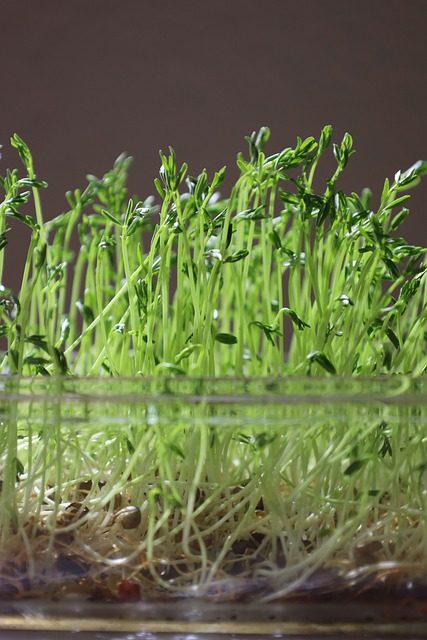Imagine having a continuous supply of fresh, nutritious greens right at your fingertips, grown from the comfort of your home. Microgreens are the answer, offering a sustainable and delicious way to incorporate more greens into your diet. In this comprehensive guide, we’ll explore everything you need to know about growing these tiny powerhouses, from selecting the right seeds to harvesting and enjoying the fruits of your labor.
Table of Contents
Key Takeaways
Learn how to enjoy fresh, nutrient-rich microgreens year-round with this comprehensive guide.
Discover the numerous health benefits of growing your own microgreens and creative ways to incorporate them into meals.
Make a positive environmental impact by cultivating healthy and thriving microgreens sustainably at home!
Understanding Microgreens

Microgreens are young, edible seedlings of vegetables and herbs, harvested after the cotyledon leaves have developed, offering intense flavors and high nutrient density. These tiny plants can be grown from a variety of microgreens seeds, allowing you to grow your own microgreens. Popular options include fresh microgreens such as:
kale
peas
arugula
basil
Growing microgreens at home is not only simple and cost-effective, but it also provides a source of fresh greens during the winter months in colder climates and during the hot summer months in hotter climates where it may be too warm to grow salad greens outside.
The steps to cultivate microgreens are simple:
Choosing suitable seeds
Setting up the growing area
Sowing and germinating seeds
Tending to the microgreens
Harvesting and storing them
In just a matter of weeks, you can reap the benefits of your labor, enjoying microgreens at their peak flavor and nutritional value.
Health Benefits of Microgreens
Microgreens are packed with vitamins, minerals, fiber, and antioxidants, providing numerous health benefits and disease prevention properties. When you eat a microgreen, you get an abundance of nutrients that would otherwise spread to the whole plant, making them known as baby greens. These tiny plants may contain a higher concentration of nutrients than their mature counterparts, boasting high vitamin and carotenoid concentrations.
Microgreens like broccoli from the Brassica family are nutrient-dense, rich in Vitamin E, a potent phenolic antioxidant. In contrast, Asteraceae microgreens, including chicory and lettuce, are loaded with Vitamin A and carotenoid antioxidants. These nutritional powerhouses offer many health benefits, including:
Boosting immune function
Supporting heart health
Improving digestion
Enhancing skin health
Reducing the risk of chronic diseases
Given their impressive nutritional content, it’s unsurprising that microgreens have gained popularity among health enthusiasts.
Learn more, visit What are the Health Benefits of MicroGreens?
Choosing the Right Seeds for Microgreens
Selecting the perfect seeds for microgreens is an exciting process, as there are many factors to consider such as ease of growth, nutritional content, and personal taste preferences. Great choices for microgreen seeds include:
Kale
Peas
Arugula
Basil
These seeds are not only easy to grow but also offer an abundance of nutrition in each bite.
For beginners, some easy-to-grow and rewarding varieties of microgreens, especially when growing microgreens indoors, include:
Broccoli
Cauliflower
Cabbage
Mustard
Chia
Sunflower
Buckwheat
Commercial seeds are often treated with beneficial fungicides and pesticides to protect them during storage. However, when growing microgreens for consumption, you may want to consider using certified organic or untreated seed to ensure your greens are free from harmful chemicals, particularly since microgreens are often eaten raw.
Preparing Your Growing Space
Preparing your growing space for microgreens involves setting up an indoor or outdoor environment with proper containers, soil, and drainage. Many people prefer to grow microgreens indoors for better control over the growing environment.
In the following subsections, we’ll discuss the specific requirements for both indoor and outdoor setups.
Indoor Setup
Cultivating microgreens indoors requires:
Containers with drainage holes, like fruit plastic containers or clamshell takeout boxes
Soil, preferably potting mix, should be sufficient for the germinated seeds to develop into microgreens
Ideally, the container should be filled with a moist growing medium to a depth of 2-3cm (1 inch).
For optimal growth, microgreens require at least four hours of sunlight a day. A sunny windowsill may provide enough light, but if not, a grow light can be used to significantly accelerate the growth of microgreens.
Outdoor Setup
Microgreens can thrive outdoors in the garden as well. Soil preparation is a vital step for a successful outdoor microgreen setup. It is imperative to protect the plants from severe weather and ensure they receive sufficient sunlight.
It’s important to maintain the right humidity and properly water the microgreens for optimal growth, keeping the soil moist. Whether you’re growing microgreens in an indoor or outdoor setup, shallow containers with excellent drainage are ideal.
Planting and Germinating Microgreen Seeds
It is advisable to pre-soak larger seeds in warm water for several hours or overnight to enhance germination before planting. Once prepared, distribute the seeds evenly across the moist growing medium in your container, avoiding overcrowding. Proper moisture levels are vital for the seeds to sprout and develop into nutritious microgreens.
As your seeds sprout and develop their seed leaves, you’ll need to remove any coverings to allow the seedlings to receive light and flourish. With just a little care and attention, you’ll soon have a thriving microgreen garden to enjoy.
Caring for Your Microgreens
Promoting healthy growth of your microgreens entails adopting appropriate watering methods and managing light effectively.
In the following subsections, we’ll discuss how to keep your microgreens hydrated and ensure they receive adequate light for optimal growth.
Watering Techniques
Misting microgreens with a spray bottle is an effective watering approach, as it reduces the chances of damage to the fragile seedlings. Also, keeping moisture levels consistent in the growing medium is integral to fostering healthy growth.
Watering your microgreens daily is essential for optimal growth. Proper hydration, combined with good airflow, will help prevent issues such as mold and ensure your microgreens thrive.
Light Management
Even light exposure is key for robust and healthy growth of microgreens. This can be achieved by:
Periodically rotating the trays, ensuring all seedlings get equal light
Providing sufficient sunlight or supplemental artificial light for optimal growth
Using a grow light if natural sunlight is insufficient, especially during winter months
By managing watering techniques and light exposure, you’ll be well on your way to nurturing a thriving microgreen garden.
Harvesting and Storing Microgreens

Harvesting microgreens is a simple and rewarding process. Here’s how to harvest microgreens:
When the seedlings reach a height of 2.5-10cm (1-3 inches), it’s time to harvest.
Using scissors, snip the stems above the soil line when the first set of true leaves appear.
This ensures you’re getting the most nutrients and flavor from your microgreens.
Once harvested, gently wash your microgreens and store them in a plastic bag in the refrigerator. This will help maintain their freshness and nutrient content, allowing you to enjoy the health benefits of microgreens in various dishes for days to come.
Creative Ways to Enjoy Microgreens
There are countless creative ways to enjoy microgreens beyond simply adding them to a salad. Here are some ideas:
Incorporate them into sandwiches
Add them to pasta dishes
Use them as stylish garnishes for steaks or fish
Mix them into omelettes or scrambled eggs
Blend them into smoothies or juices
The intense flavors and vibrant colors of red cabbage microgreens can elevate any dish, making them a versatile addition to your culinary repertoire.
Don’t be afraid to experiment with different microgreen varieties in your recipes. You might be pleasantly surprised by the unique combinations of flavors and textures you can create. The possibilities are endless when it comes to incorporating these tiny powerhouses into your meals.
Troubleshooting Common Microgreen Issues
While cultivating microgreens is relatively simple, common challenges like mold, uneven growth, and pests may occur. However, with careful attention and care, these issues can be managed. Here are some tips to address these challenges:
Mold prevention: Maintain appropriate humidity in the growing area and avoid overwatering the microgreens.
Even growth: Provide consistent light, water, and nutrient supply to ensure uniform growth.
Pest control: Regularly inspect the microgreens for pests and take appropriate measures to eliminate them.
By following these tips, you can successfully microgreens grow, cultivating healthy and thriving plants.
Pests can be managed through natural pest control methods such as companion planting or using insecticidal soap. By identifying and addressing these common issues in agricultural and food chemistry, you’ll ensure a successful harvest and enjoy the fruits of your labor.
Sustainability and Microgreens

Microgreens support sustainability by offering a local, seasonal, and nutrient-dense food source, which can thrive in small spaces with limited resources. As a sustainable food option, microgreens present an eco-friendly substitute for traditional greens that typically require more space and are often transported over long distances before they reach your table.
By growing microgreens at home, you’re not only enjoying their numerous health benefits but also contributing to a more sustainable food system. This eco-friendly approach to healthy eating can have a positive impact on both your well-being and the environment.
Summary
Growing microgreens at home is an enjoyable and rewarding way to incorporate fresh, nutrient-dense greens into your diet. From selecting the right seeds, preparing your growing space, and nurturing your microgreens, you’ll be well on your way to enjoying the health benefits and delicious flavors these tiny plants have to offer. Embrace the sustainable and eco-friendly aspects of microgreens, and embark on your own microgreen journey today.
Frequently Asked Questions
What is the benefits of eating microgreens?
Eating microgreens is a great way to get an abundance of vitamins and minerals, including vitamin A, E, C, K, calcium, magnesium, iron, selenium and zinc. Incorporating these nutrient-packed greens into your daily diet can help keep you healthy and strong.
Are microgreens better for you than regular greens?
Microgreens contain significantly more vitamins, minerals, and other phytochemicals than fully grown greens. They also have higher concentrations of key nutrients like folate and vitamin A, making them a more nutrient-dense choice than regular greens.
Do microgreens grow back after you cut them?
Do microgreens grow back after cutting? Many types of microgreens, such as pea shoots, regrow after being harvested when they are cut just above the lowest leaf. This can be done multiple times for a continued harvest of your greens.
Are microgreens easy to grow?
Yes, microgreens are surprisingly easy to grow right at home – all you need is a windowill in your kitchen and you can have a fresh batch of microgreens ready to top your meals in no time!
What are microgreens?
Microgreens are packed with intense flavor and nutrition, adding freshness and zest to any dish! Enjoy the culinary benefits of these young seedlings harvested from vegetables and herbs. Microgreens are a great way to add flavor and nutrition to any dish. They are harvested when the seedlings are young, and are packed with intense flavor and nutrition. They can be used









